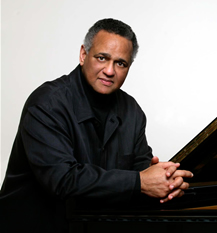In Page Auditorium on the campus of Duke University, the focus was on the music. This asceticism was emphasized by the bare stage, graced only by one of the university’s fine new Steinways. André Watts is a much-beloved soloist who has appeared many times, either as a concerto soloist with several of the state’s symphony orchestras or in recital. This thoughtful program sampling Franz Liszt’s compositions reminded me of Watts’ mid-1980s appearance on the long-defunct Friends of the College Series in Raleigh. NCSU’s on-campus basketball palace, William Neal Reynolds Coliseum, was packed to the rafters for an all-Liszt program repeated on two nights.
The Duke Program contained superb notes about the pieces and the composer by Susan Halpern, ©2011. My comments draw heavily upon these and Franz Liszt: The Man & His Music, edited by Alan Walker. While Liszt established his career with his peerless keyboard technique, his efforts to expand beyond established compositional norms have had more lasting effects. He created the symphonic poem, a major element of Romantic music, and brought a greater emphasis on using folk music in art-music. He exploded the boundaries of the symphony, sonata, and concerto. He was extraordinarily generous in support of younger composers, and he was a hugely influential teacher. My favorite Liszt works are those from his old age when he anticipated the styles of the Impressionists and the Schoenberg School decades before them.
Watts’ concert opened with one of Liszt’s best-loved pieces, Étude de concert No. 3, “Un Sospiro,” a study in creating a seamless, singing line that involves enough crossed hands to remind one of a showy Scarlatti sonata. From Années de Pèlerinage (Years of Pilgrimage), Volume III, the pianist selected “Les Jeux d’eau a la Villa d’Este.” The composer sought to depict the cypresses and fountains of the gardens of the Villa d’Este at Tivoli, near Rome. The impressionist surges of sound suggest the interplay of water in a fountain. The music anticipates the colorful sound palette of Debussy and Ravel.
The first half of Watts’ recital ended with Liszt’s challenging and revolutionary Sonata in B Minor. The composer created a bold, new structural plan in such works as the First Piano Concerto and the Faust Symphony. Traditional separate movements are eschewed, and everything is integrated into a single, continuous entity. Halpern succinctly describes Liszt’s technique as “the constant expansion of motives and transformation of melodies, a process of synthesis in place of the classicists’ development.”
Watts clearly wanted to divide his post-intermission program into two sets not to be interrupted by applause but the audience had a mind of its own and did not take the hint from his remaining seated between selections. One of Liszt’s most experimental pieces, “Bagatelle ohne Tonart” (Bagatelle without Tonality) opened the first set of five pieces. More than twenty-five years before Schoenberg’s abandonment of tonality, Liszt conjured up this ambivalent piece with hovering tonality that ends suddenly on a diminished seventh chord. Another anticipation of Impressionism followed, the ascetic and gloomy “Nuages Gris,” S.199 (Grey Clouds). Liszt was psychologically insightful in evoking the elusive dream state in “En Rêve” (Dreaming). A solemn funeral procession on the Grand Canal in Venice inspired Liszt to compose “La Lugubre Gondola” No. 2 (Funeral Gondola). He came to believe a presentment of Richard Wagner’s death had stimulated his creating this harmonically adventuresome work. At the time Liszt was sharing a large apartment in one of the famous palaces on the Grand Canal with his son-in-law, Wagner. The set ended with “Schlaflos-Frage und Antwort” (Sleeplessness-Question and Answer), S.203, a nocturne that contrasts a dark, fervent section set against a spare, unsettling conclusion.
Watts’ second and concluding set consisted of Étude No. 2 in E-flat from Six Grand Études after Paganini, Transcendental Étude No. 10 in F Minor, and the Hungarian Rhapsody No. 13 in A Minor. Liszt wanted to emulate for the piano the spectacular violin pyrotechnics of Paganini. Halpern aptly describes the Transcendental Etude No. 10 as “fiercely dramatic,” and it is equally demanding of the pianist’s agility and power. The Hungarian Rhapsody No. 13 combines “slow-fast contrasts” with an evocation of the hand-held hammers of the cimbalom. After a very enthusiastic, prolonged standing ovation, Watts played a lovely, unannounced encore piece which featured a distinctive song-like theme.
The decades have not dampened Watts’ chops! He seemed effortlessly to conjure up huge tsunamis of sound, and he produced a broad kaleidoscope of keyboard color. He produced a rich, warm tone. His agility and precision in the fastest passages was amazing, as was his care for dynamics, whether unleashing thundering chords or floating a hushed ppp. Watts seemed to be more restrained in making grand gestures as he played, though they were not completely absent, nor should they be in Liszt. He held the potentially sprawling B minor Sonata together beautifully, meeting every technical demand while not losing the overall view. His magical touch in the Impressionist Liszt selections whetted the appetite for a Watts survey of Debussy, Fauré, and Ravel. Many of the Liszt selections on this program are still available on two EMI CDs, André Watts Plays Liszt Albums 1 and 2.











